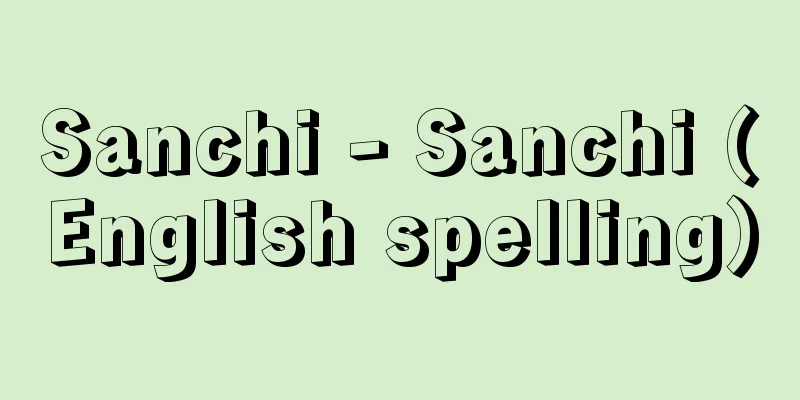Mortar - Usu

|
A type of utensil for cooking and preparing grains. It is used for threshing, polishing, and milling grains such as rice and wheat, as well as for pounding mochi (rice cakes), pounding miso, and making konjac, and is broadly divided into mortars and pestle mortars and grinding mortars depending on their structure and function. [Mizuo Miyamoto] mortarThe most common is the vertical mortar, which can be made of wood or stone. It is shaped like a cylinder made by slicing a large tree into a ring, with a concave hollowed out top, into which grains are placed and pounded using a rod-shaped vertical pestle (hand pestle) or a T-shaped horizontal pestle. However, mortars for vertical pestle use have an egg-shaped depression and are generally suited to flour milling, while those for horizontal pestle use have an orange-shaped depression and are said to be more suited to polishing rice and pounding mochi. Vertical mortars and vertical pestles have been popular throughout Southeast Asia since ancient times, and were introduced to Japan during the Yayoi culture period along with rice cultivation, and a drum-shaped mortar with a handle from that time has been excavated from the Toro ruins in Shizuoka City. Also, a bronze bell bearing a kesadasukimon design from the same period, said to have been excavated in Kagawa Prefecture, is famous for depicting two people taking turns pounding rice with a vertical mortar. For a long time after that, tasks such as threshing, polishing, and milling were carried out with vertical mortars and pestles, but with the appearance of horizontal pestles around the middle of the Edo period (late 18th century), horizontal pestles came to be used for threshing, polishing, and pounding rice cakes, and vertical pestles were only used to a limited extent in Izu, Satsuma (Kagoshima Prefecture), Okinawa, and other islands for milling flour and pounding miso until recent years. Another type of mortar is the fumiusu, which is often made of stone and is moved by attaching the pestle to one end of a long, lever-shaped piece of wood and stepping on the other end with the foot. Called karausu or jigara (mortar), the name can be seen in documents from the Heian period, but it was not until the mid-Edo period that it became common and was used exclusively for polishing rice. The power source, which was driven by foot, was later replaced by a waterwheel, and a mill in which the rotation of the waterwheel was transmitted to a square pestle to move it up and down was widely used as a general milling tool up until the Meiji and Taisho periods. There is another type of mill, the boat-shaped yokosu. [Mizuo Miyamoto] Grinding mortarGenerally, it consists of an upper mill and a lower mill, with the lower mill fixed and rotating around the axle of the lower mill. The raw materials are fed through holes in the upper mill, and the friction of the teeth on the contact surfaces of the upper and lower mills removes the rice husks and turns the material into powder. Since ancient times, the rotation of this grinding mill has been achieved using human strength as well as water and animal power. Wooden grinding mills are called wooden mortars or grinding mills, and are rotated by two people sitting opposite each other and pulling on the pull rope of the upper mill. According to the technical book "Tianzong Kaibutsu" from the Ming Dynasty in China, Chinese mills are flat in shape, while those used in Japan, Korea, Myanmar (Burma), etc. are long and cylindrical, and although their shapes appear different at first glance, their origins are probably in China. In Japan, they were used for hulling rice as early as the Heian period, but from the mid-Edo period, clay mortars came into widespread use, and their use finally declined, with only small farms using them until the Meiji period. They are still in use in Okinawa, Korea, Myanmar, and other places. Meanwhile, clay mortars are also called earthen mortars, karamushi mortars, surusu mortars, etc., and are made by weaving the outer periphery of both the upper and lower mortars with bamboo, filling the inside with soil, and embedding oak or teak teeth between the upper and lower contact surfaces. Small ones have a spear attached to the crossbeam of the upper mortar to rotate it, and large ones have a mechanism that rotates the upper mortar by changing the linear motion of several people pushing and pulling it back and forth into a circular motion. Clay mills have been used in China for a long time, but in Japan they became common around the Genroku period (1688-1704) during the Edo period. They were more efficient than wooden mills for husking rice. Therefore, they were quickly adopted by large-scale landowners, and were used as the primary husking tool until the Taisho and Showa periods when powered rice polishers became widespread. They are still in use in Korea, Indochina, Thailand, Myanmar, and other places. Stone mills are called stone mills or grinding mills, and both the upper and lower mills are made of stone, with a support made of a board or a wooden bowl. Small ones are turned by attaching a handle to the upper mill, and large ones are turned by two or three people holding a stick. Stone mills have been used in China for a long time, and were introduced to Japan as early as the Asuka period. At first, small mills were used for special purposes such as preparing medicines and paints and making tea, but from around the mid-Edo period, they became popular among ordinary farmers. They were mainly used to grind rice and wheat, but were also used to make buckwheat flour, soy flour, and tofu. They are still used today in China and India. [Mizuo Miyamoto] FolkloreUsu have been used as important tools for pounding rice and mochi to be offered to gods and Buddhas, and for preparing food such as grains, so they have been treated with great care since ancient times and have been associated with many rituals and popular beliefs. First of all, when making a mortar, great care was taken in selecting the wood, and when storing it, it was generally placed near the main pillar of the farmhouse, and when storing it in a barn, it was stored on a platform so that it would not directly touch the ground. Moreover, when a new house was built or there was a fire, the mortar was removed first, and when disposing of an old mortar that could no longer be used, it was common to break it and distribute it to seven neighboring houses to be burned and turned into ashes. In particular, the story in the "Zenkoji Engi" that the principal image of Zenkoji Temple in Nagano was originally placed on a mortar is famous, but the portable shrines of Atsugi Shrine in Atsugi, Kanagawa Prefecture, and Yasaka Shrine (within Enoshima Shrine) on Enoshima are also said to rest on mortars. Also, a large stone mill is worshipped as a deity for Ichigami and Ichihime in Wajima, Noto Peninsula, Ishikawa Prefecture. Furthermore, a mortar is used as an altar to welcome Toshigami during New Year's events, and the custom of offering Kagami-mochi and young water to the mortar and pounding rice cakes at the start of work on the second day of the New Year is seen almost all over the country. On the other hand, there is also the custom of using a mortar as an altar on the tenth night (October 10th) during the harvest season and on the first day of the ox in November. In all of these cases, the mortar is considered to be pure and sacred. This view of the mortar went further, and people came to consider it to be a tool that holds some special magical power. For example, at funerals, in order to cleanse the room after the funeral, a mortar is rolled while chanting, and people returning from the funeral purify themselves with the salt on the upside-down mortar before entering the house. Along with the idea that the mortar represents women and the pestle represents men, customs related to marriage, childbirth, and child-rearing are also widely practiced. There are many examples, such as pounding rice with three pestles in preparation for auspicious events, pounding rice cakes on both sides of the entrance at a wedding, the husband of a pregnant woman carrying a mortar on his back and walking around the house during a difficult birth, the belief that having a pregnant woman hold a mortar will ensure an easy birth, and the belief that when a married girl returns to her parents' home for the first time and places the baby in a mortar, the baby will grow up healthy. Furthermore, there are events around the end of the year, such as Usubase and Usuyasume, which are used to predict the fortunes of the year, and all of these can be said to be legends that demonstrate the magical power of the mortar. Meanwhile, such rituals and popular beliefs relating to mortars are also widely found among the various ethnic groups in Southeast Asia. First of all, the idea that the mortar is a female symbol and the pestle a male symbol is widely accepted among various ethnic groups, but there are also other examples. For example, the Tingyan people of Luzon place offerings on a mortar when performing a spell to recover from an illness, and a shrine maiden walks around it praying. Among the Malay people of the Malay Peninsula, at wedding ceremonies, the bride and groom walk around an upside-down mortar three times and then sit on it. In Java, solar and lunar eclipses are believed to be the result of a heavenly monster trying to capture the sun and moon, and in order to save them, there is a custom of striking the mortar to make a loud noise and scare off the monster. [Mizuo Miyamoto] Shigeo Miwa, Cultural History of Things and Humans 25: Mortar (1978, Hosei University Press) ©Mitsuyoshi Tashiro "> Types of mortars and how to use them ©Mitsuyoshi Tashiro "> Types of pestle ©Mitsuyoshi Tashiro "> Types of mortars and how to use them Source: Shogakukan Encyclopedia Nipponica About Encyclopedia Nipponica Information | Legend |
|
穀類などの調理・調整用具の一種。米、麦など穀類の脱穀、精白、製粉をはじめ、餅搗(もちつ)き、みそ搗き、コンニャク作りなどにも使われ、その構造、機能により、搗臼(つきうす)と磨臼(すりうす)とに大別される。 [宮本瑞夫] 搗臼もっとも広く一般的なのは竪臼(たてうす)で、これには木製と石製がある。その形は、ちょうど大木を輪切りにした円筒状で、この上部を凹形にくりぬいて、そこに穀類を入れ、棒状の竪杵(たてぎね)(手杵)あるいはT字状の横杵を使って搗く。ただし、竪杵用の臼はくぼみが卵状で、一般に製粉に適し、横杵用は蜜柑(みかん)状で、精白、餅搗きなどに適しているといわれる。竪臼、竪杵は古くから東南アジア各地に普及し、日本にも稲作とともに弥生(やよい)文化時代に伝えられ、静岡市の登呂(とろ)遺跡から、当時の鼓(つづみ)形で取っ手付きの臼が出土している。また、香川県出土と伝える同時代の袈裟襷文銅鐸(けさだすきもんどうたく)には、2人の人物が1個の竪臼を中心にして交互に竪杵を搗いている光景がみられることは著名である。以後、長い間、竪臼、竪杵によって、脱穀、精白、製粉といった作業が行われてきたが、江戸時代中期(18世紀後半)ごろ横杵の出現によって、脱穀、精白、餅搗きなどには横杵が用いられるようになり、竪杵は、近年まで、伊豆、薩南(さつなん)(鹿児島県)、沖縄などの諸島で、製粉、みそ搗きなどに、わずかに使用されるにとどまった。このほか、搗臼の一種に踏臼(ふみうす)があるが、これは石製が多く、杵の運動は、てこ状の長木の一端に杵をつけ、他端を足で踏んで行った。唐臼(からうす)、地唐(じがら)(臼)などといい、すでに平安時代の文献にもその名がみえているが、一般化したのは江戸中期以後で、もっぱら精白用として用いられた。足で踏む動力は、その後、水車に変わり、水車の回転を角柱の杵に伝えて上下運動させるものが、以後の一般的精白用具として、明治・大正時代に至るまで広く用いられていた。なお、搗臼には、ほかに舟形をした横臼(よこうす)がある。 [宮本瑞夫] 磨臼一般に上臼(うわうす)と下臼(したうす)とからなり、下臼を固定し、上臼が下臼の心棒(しんぼう)を軸として回転する構造になっている。上臼の穴から投入された原料は、上下両臼の接触面につくられた歯の摩擦によって、籾殻(もみがら)を除き、粉末にされる。この磨臼(すりうす)の回転には、古くから人の腕力のほか水力や畜力が利用された。木製の磨臼は木臼、挽臼(ひきうす)とよばれ、上臼の引き綱を対座した2人が引き合って回転させる。中国明(みん)代の技術書『天工開物(てんこうかいぶつ)』によると、中国のものはその形が平たく、日本や朝鮮、ミャンマー(ビルマ)などで使用されているものは細長い円筒形で、一見、形態は異なるが、その起源はおそらく中国にあると思われる。日本では、早く平安時代から籾摺(もみす)りに使用されていたが、江戸中期から土製の磨臼が広く使用されるようになって、その利用はようやく衰え、わずかに小農家などで明治以後まで使用されていた。沖縄、朝鮮、ミャンマーなどではいまもなお使用している所がある。一方、土製の磨臼は土臼、唐臼(とううす)、籾摺臼(もみすりうす)、磨臼(するす)などといい、上下両臼ともに竹木で外周を編み、その内部に土を詰め、上下の接触面にカシの木、チーク材などの歯を埋め込んでつくる。小形のものは、上臼の横木に遣木(やりぎ)をつけて回転し、大形のものは、数人で前後に押し引きして動かす直線運動を円運動に変えて、上臼を回転する仕掛けになっている。土製の磨臼(すりうす)も中国では古くから使用されていたらしいが、日本では江戸時代も元禄(げんろく)(1688~1704)のころから一般化した。籾摺り用としては、木製の磨臼より能率は高いものであった。したがって、大規模の地主経営でいち早くこれを採用し、大正・昭和に入って動力精米機が普及するまで、有力な籾摺り用具として利用された。朝鮮、インドシナ、タイ、ミャンマーなどではいまも使用されている。石製の磨臼は、石臼、挽臼とよばれ、上下両臼とも石でつくり、これに板製あるいは木鉢(きばち)などの受け台を併用する。小形のものは上臼に取っ手をつけて回し、大形のものは遣木をもって2、3人で回転させる。この石製磨臼も中国では古くから使用され、日本にも早く飛鳥(あすか)時代に伝来している。初めは、小形のものが、薬剤、絵の具の調製や製茶など特殊の用途に利用されていたが、江戸中期ごろから一般農家にも普及した。主として米、麦の製粉に使用されたが、そば粉、大豆粉、豆腐の製造などにも用いた。現在も中国はじめインドなどでも使用されている。 [宮本瑞夫] 民俗臼は、神仏に供える粢(しとぎ)や餅を搗き、また穀物など食料調製のための重要な道具として用いられたので、古くからたいせつに扱われ、多くの儀礼、俗信を伴うこととなった。まず、臼を製作するにあたっては、木の選定に大きな注意が払われ、保管にあたっては、一般に農家の母屋(おもや)の大黒柱のそばに置かれ、納屋に収納する場合には、直接、地面に触れないように、台を設けてその上に収納した。しかも、家を新築したときや火災のときには、まず臼から先に運び出し、さらに、使用不能となった古臼の処分には、これを割って近隣7軒に配り、燃やして灰にしてもらうという習俗が一般に行われていた。とくに、長野の善光寺の本尊が初め臼の上に安置されたという『善光寺縁起』の説話は有名だが、神奈川県厚木の厚木神社や江の島の八坂神社(江島(えのしま)神社内)の神輿(みこし)も臼の上に休息するという。また、石川県能登(のと)半島輪島の市神(いちがみ)、市姫様には、大きな石臼が御神体として祀(まつ)られている。さらに、正月行事でも、歳神(としがみ)を迎える祭壇として臼が使用され、これに鏡餅(かがみもち)や若水を供え、正月2日の仕事始めに、臼をおこして餅を搗いたりする習俗は、ほぼ全国各地にみられる。他方、収穫時における十日夜(とおかんや)(10月10日)や11月の初丑(はつうし)の日などにも、臼を祭壇に使用する習俗が行われている。これらはいずれも臼を清浄なものとし、神聖視しているからであろう。こうした臼に対する考え方は、さらに進んで、なにか特別な呪力(じゅりょく)を秘めた道具と意識されるようになっていった。たとえば、葬式に際して、出棺後の部屋を掃き清めるために、唱え詞(ごと)をしながら臼を転がすことが行われ、葬送から帰った人々が、伏せた臼の上の塩で身を清めたのち、初めて家に入る。また、臼を女性に、杵を男性に見立てる思想とともに、婚姻、出産、育児に関する習俗も広く行われているが、吉事の支度に三本杵で米を搗くのをはじめ、嫁入りに入口の左右で餅搗きを行うとか、難産のときに妊婦の夫が臼を背負って家の周囲を巡るとか、妊婦に臼を抱かせると安産するといわれ、また、嫁入りした娘が初めて生児を連れて実家に帰ったとき、その児(こ)を臼の中に入れると健康に育つといった俗信など、多くの事例がみられる。さらに、年末年始にかけても、その年の吉凶を占う臼伏せ、臼休めの行事があり、これらはすべて臼の呪力を示した伝承といえよう。 一方、このような臼に関する儀礼、俗信は、また広く東南アジアの諸民族の間にもみられる。まず、臼を女性の、杵を男性のシンボルとする思想は、諸民族の間に広く認められるものであるが、このほか、たとえばルソン島のティンギアン人は、病気回復の呪術に際し、臼の上に供え物をし、巫女(みこ)がその周囲を祈りながら回る。マレー半島のマレー人の間には、結婚式に新郎新婦が逆さに伏せた臼の周りを三度巡って、これに座ることがある。またジャワでは、日食、月食は天上の怪物が日、月を捕らえるためと考えられ、これを救うために臼をたたいて大きな音を出して、この怪物を脅かす習俗がある。 [宮本瑞夫] 『三輪茂雄著『ものと人間の文化史25 臼』(1978・法政大学出版局)』 ©田代三善"> 搗臼の種類と使い方 ©田代三善"> 杵の種類 ©田代三善"> 磨臼(挽臼)の種類と使い方 出典 小学館 日本大百科全書(ニッポニカ)日本大百科全書(ニッポニカ)について 情報 | 凡例 |
<<: Vortex - Uzu (English spelling)
>>: Konstantin Dmitrievich Ushinskiy
Recommend
Real estate acquisition tax
A prefectural tax levied when ownership of land o...
Hilar lymph node tuberculosis
This is the most common type of early tuberculosi...
Advisory Opinion - Kankokute Kiiken (English spelling) Advisory Opinion
The International Court of Justice, at the request...
Mintaka Pass (English spelling)
A pass near the border crossing of Pakistan, Afgha...
River density - Kasenmitsudo
…For example, when faults or rock joints control,...
railway mania
…In particular, the ability to transport raw mate...
Akiyama's Chronicles
Written by Suzuki Bokushi, born in Shiozawa, Echig...
Scrofulosis
…In slang, it has been used to mean a weak consti...
Cherry brandy
A liqueur made from cherries. Cherries are soaked...
Yusuf Idris (English spelling)
…The Realist school was pioneered by al-Sharqāwī ...
Flower Priest - Kawajo
…His real name was Lu Da, and his Buddhist name w...
Chorea minor (English)
…He described gout, chorea, pneumonia, and other ...
Arab Socialist Union
...The leadership was formed by a core of Free Of...
Stem tea - Kukicha
<br /> A type of green tea. The stems and pe...
Iwashiro Province
This province was established on December 7, 1868...









